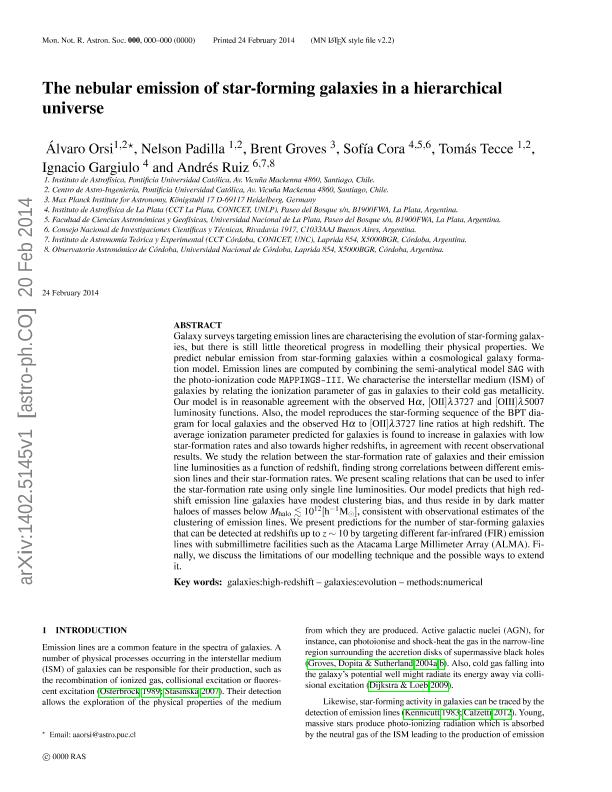Artículo
The nebular emission of star-forming galaxies in a hierarchical universe
Orsi, Alvaro; Padilla, Nelson David ; Groves, Brent; Cora, Sofia Alejandra
; Groves, Brent; Cora, Sofia Alejandra ; Tecce, Tomas Enrique
; Tecce, Tomas Enrique ; Gargiulo, Ignacio Daniel
; Gargiulo, Ignacio Daniel ; Ruiz, Andrés Nicolás
; Ruiz, Andrés Nicolás
 ; Groves, Brent; Cora, Sofia Alejandra
; Groves, Brent; Cora, Sofia Alejandra ; Tecce, Tomas Enrique
; Tecce, Tomas Enrique ; Gargiulo, Ignacio Daniel
; Gargiulo, Ignacio Daniel ; Ruiz, Andrés Nicolás
; Ruiz, Andrés Nicolás
Fecha de publicación:
07/2014
Editorial:
Wiley Blackwell Publishing, Inc
Revista:
Monthly Notices of the Royal Astronomical Society
ISSN:
0035-8711
Idioma:
Inglés
Tipo de recurso:
Artículo publicado
Clasificación temática:
Resumen
Galaxy surveys targeting emission lines are characterizing the evolution of star-forming galaxies, but there is still little theoretical progress in modelling their physical properties. We predict nebular emission from star-forming galaxies within a cosmological galaxy formation model. Emission lines are computed by combining the semi-analytical model SAG with the photoionization code MAPPINGS-III. We characterize the interstellar medium of galaxies by relating the ionization parameter of gas in galaxies to their cold gas metallicity, obtaining a reasonable agreement with the observed Hα, [O II] λ 3727, [O III] λ 5007 luminosity functions, and the BPT diagram for local star-forming galaxies. The average ionization parameter is found to increase towards low star formation rates and high redshifts, consistent with recent observational results. The predicted link between different emission lines and their associated star formation rates is studied by presenting scaling relations to relate them. Our model predicts that emission-line galaxies have modest clustering bias, and thus reside in dark matter haloes of masses below Mhalo ≲ 1012 [h−1 M⊙]. Finally, we exploit our modelling technique to predict galaxy number counts up to z ∼ 10 by targeting far-infrared emission lines detectable with submillimetre facilities.
Palabras clave:
Numerical Methods
,
Evolution of Galaxies
,
High Redshift
,
Surveys
Archivos asociados
Licencia
Identificadores
Colecciones
Articulos(IALP)
Articulos de INST.DE ASTROFISICA LA PLATA
Articulos de INST.DE ASTROFISICA LA PLATA
Articulos(IATE)
Articulos de INST.DE ASTRONOMIA TEORICA Y EXPERIMENTAL
Articulos de INST.DE ASTRONOMIA TEORICA Y EXPERIMENTAL
Citación
Gargiulo, Ignacio Daniel; Tecce, Tomas Enrique; Cora, Sofia Alejandra; Groves, Brent; Padilla, Nelson David; Orsi, Alvaro; et al.; The nebular emission of star-forming galaxies in a hierarchical universe; Wiley Blackwell Publishing, Inc; Monthly Notices of the Royal Astronomical Society; 443; 7-2014; 799-814
Compartir
Altmétricas



